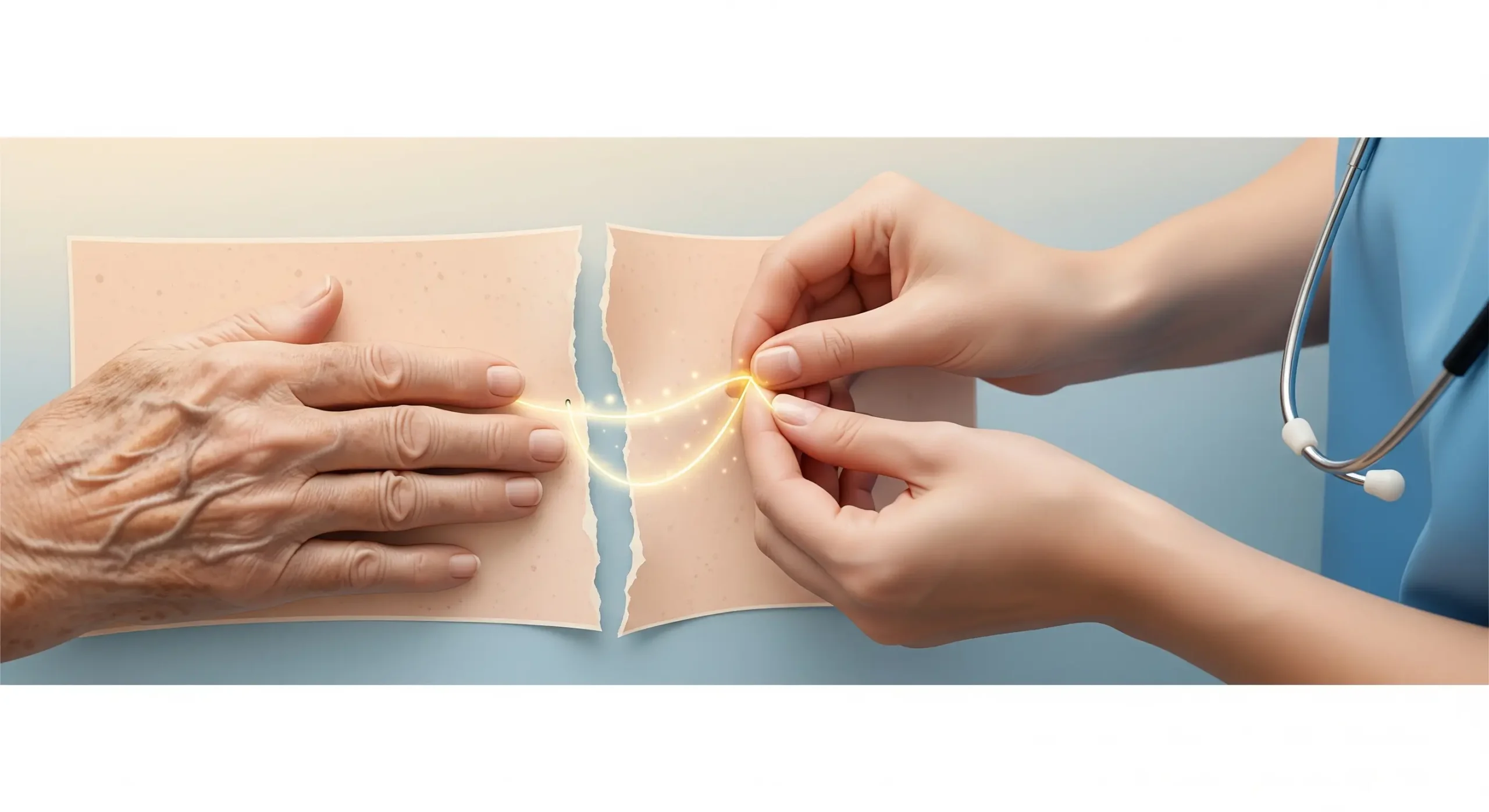
As we age, many physiological changes happen in the body, often increasing the risk of developing certain health problems related to aging. Skin tears in the elderly are among the most common issues many people face as they get older, due to several reasons that can be easily addressed with proper medical care services.
Skin tears in the elderly are common, very painful, and slow-healing wounds caused by a tear in the skin due to partial or complete separation of the layers of the skin. The reason the elderly are particularly susceptible to these stubborn wounds is due to the decrease in skin thickness and elasticity with age, the decline in dermal regeneration, and many other factors.
Elderly people are indeed more susceptible to skin tears for several reasons; the most prominent factor is that as the body ages, skin layers become thinner, lose elasticity, and have less structural support, making them more susceptible to injury and wounds.
The common causes of skin tears in the elderly that are related to aging include:
However, some other causes aren’t related to aging, such as:
The common risk factors of skin tears in the elderly include:
Skin tears in the elderly, those annoying and painful wounds, are among the most common problems that scientific and medical research seeks to address through the development of specialized treatment mechanisms. These mechanisms aim to help treat these tears, prevent them as much as possible, and alleviate the accompanying pain.
Identifying and evaluating skin tears requires consulting a specialized dermatologist to do a physical examination and using the approved screening and assessment tools that help in assessing the case.
Often, the doctor relies on the STAR or STAP classification system to assess the wound and determine the severity of the wound, the degree of tearing, and the degree of skin tissue loss, thus developing an appropriate treatment plan later.
The International Skin Tears Advisory Panel (ISTAP) has classified these skin tears into three types, as follows:
Here, the skin tears are linear tears or skin folds that can be repositioned to cover the wound and heal as much as possible.
In this type of skin tear, the tissue loss is so extensive that only a small portion of skin tissue can be repositioned over the wound surface to cover it, thus reducing the risk of infection and relieving pain as much as possible.
In these skin tears, there are no tissue fragments or flaps attached to the wound, but only an open wound surface. Unfortunately, these are the worst and most dangerous types of skin tears, as they are accompanied by excruciating pain and are susceptible to infection.
Following best practices for skin tears in the elderly helps greatly in achieving good outcomes. The most prominent of these practices is to clean the skin tear regularly with sterile water or saline solution only, and if possible, gently straighten the skin fold and bring the edges as close to the tear as possible.
If you are facing difficulties when caring for skin tears on your own, you can request home nursing services in Dubai from Lana Life Care to receive the appropriate care with precision and professionalism that ensures health and safety. The skin tear wound care service usually includes cleaning, caring, covering, and monitoring the wound until healing.
Among different types of wound dressings, you must choose the appropriate dressing for the type of skin tear. The basic dressing should not have a strong adhesive and should be made of soft silicone that is in contact with the wound to remain in place for days if possible.
The skin tears should be covered to enhance faster and safer wound healing, as it provides a moist and appropriate environment that is crucial for cell regeneration, whereas leaving the wound open without covering makes it vulnerable to dryness and infection, and delays the healing process.
This may be due to a lack of proper healthcare, exposure to contamination, or the ongoing causes of the tear, such as the continued use of certain medications that cause it or the failure to treat certain medical conditions that affect the integrity of the skin. It may also be a type III skin tear, which is difficult to heal and takes a very long time due to the lack of a skin flap around the tear.
The most important means of preventing skin tears is to assess the condition of elderly people who are at greater risk of developing skin tears, such as those with chronic and underlying diseases and those undergoing treatments that reduce the integrity and health of the skin and weaken it, to provide them with the most appropriate treatment and preventative measures.
In addition to the necessity of making some changes in the elderly’s lifestyle to reduce external risk factors, such as helping them move from one place to another, not leaving them sitting in bed for long periods, and providing professional elderly care at home to meet all their personal needs and protect them from falls and injuries.
Maintaining healthy skin is the safest way to prevent skin tears in the elderly. To achieve this, you can follow these practices:
Although requesting Home Healthcare in Dubai such as home nursing services specialized in providing appropriate healthcare for skin tears ensures the patient great comfort, safety and security, especially since Elderly Care Cost is not as expensive as some think, but, sometimes, it is better to visit a medical center or hospital to provide first aid to the patient; especially when skin tears are exposed to infection and contamination, that may lead to serious complications.
As you know, at Lana Life Care, we are committed to providing all types of professional and reliable home healthcare services through highly skilled, experienced, and DHA-licensed nurses and healthcare providers.
Because we are aware of the importance of elderly care, especially for those with skin tears, we provide them with specialized nursing care to help them manage and care for the wound, while providing all means of health and personal support to the patient to promote fast recovery.
Although our services adhere to the highest standards of quality, health, and safety, our Elderly Care Cost Per Hour is very reasonable and competitive.
Feel free to contact us now. Get a free, specialized consultation and book a home nursing service that ensures a safe, secure, and complication-free recovery from skin tears.
Cleaning the skin tear with saline solution and covering it with a sterile and suitable dressing.
It can be serious if the skin tear is exposed to severe dryness and infection.
In fact, it requires some practices to heal, especially cleansing and covering, besides following a healthy lifestyle.
Silicone and soft dressings are more suitable
Typically, skin tears may take 2 to 3 weeks to heal
No, skin tears in the elderly can be healed, but it may take a longer time for complete healing.a



